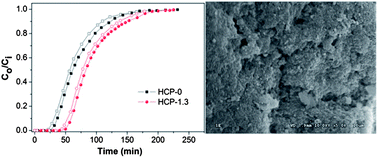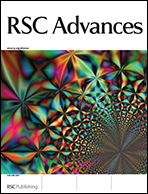Adsorption properties of benzene and water vapor on hyper-cross-linked polymers
Abstract
A series of hyper-cross-linked polymers (HCPs) was synthesized via a post-cross-linking reaction using low-cross-linked polydivinylbenzene (PDVB) as precursor and 4,4′-bis(chloromethyl)biphenyl (BCMBP) as cross-linking reagent. The effects of various amounts of BCMBP on the structures of the hyper-cross-linked polymers were discussed. The resultant typical HCP-1.3 possesses hierarchical micro/meso pore structures and a high stability up to 400 °C. The increased specific surface area and total pore volume of HCP-1.3, which reach 1231 m2 g−1 and 1.99 cm3 g−1, respectively, imply the high cross-linking ability of BCMBP. In order to study the adsorption properties of HCP-1.3, benzene and water were selected as typical adsorbates for their non-polar and polar characteristics. The static adsorption amount of benzene on HCP-1.3 is 30.0 mmol g−1, which is two times higher than the corresponding adsorbed water amount, suggesting a potential hydrophobic property of HCP-1.3. Dynamic adsorption was performed with a fixed-bed column to simulate the real situation under dry and 30% relative humidity conditions. The results show the dynamic adsorption amount under the 30% relative humidity condition is as high as 90% of the value under dry conditions, implying HCP-1.3 would be a promising adsorbent for VOC adsorption under both dry and humid conditions.


 Please wait while we load your content...
Please wait while we load your content...